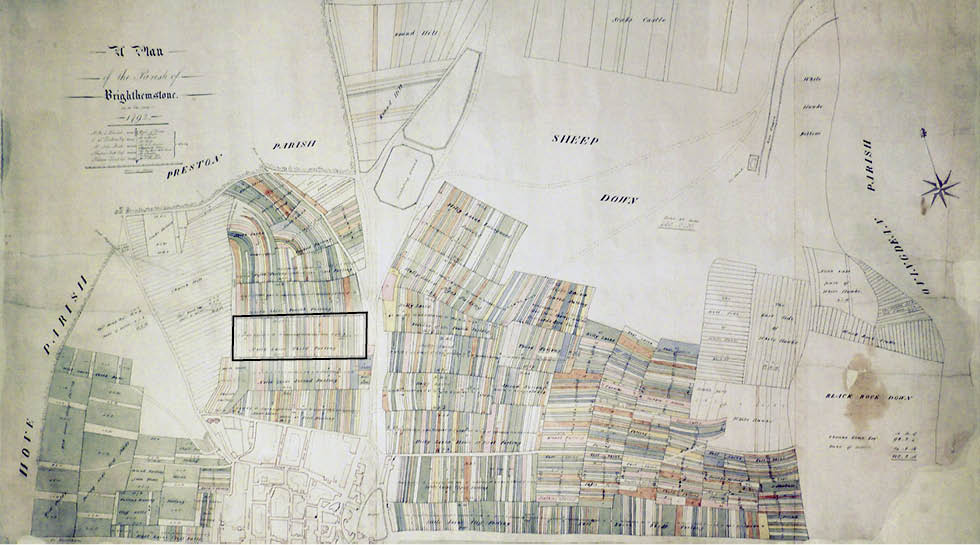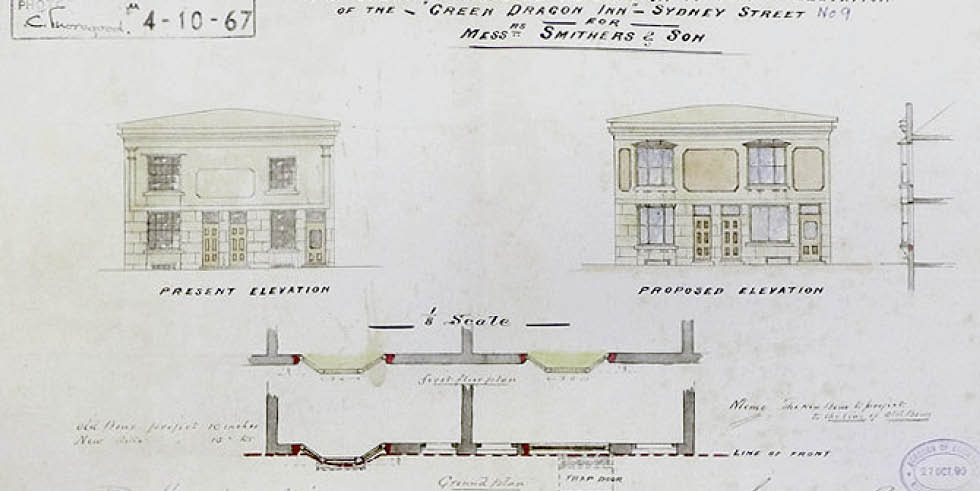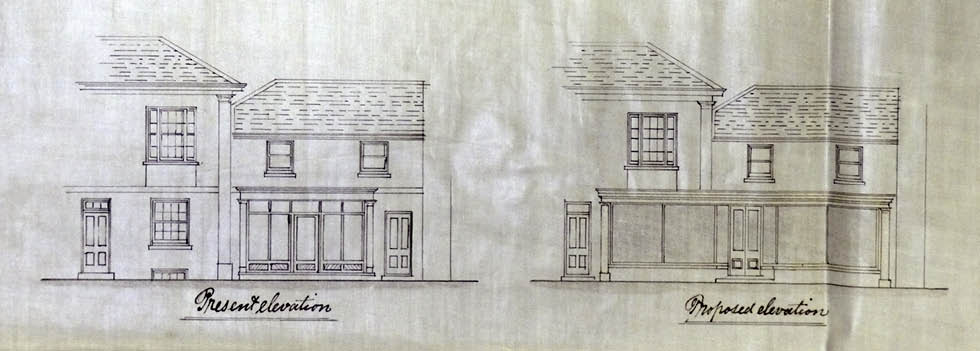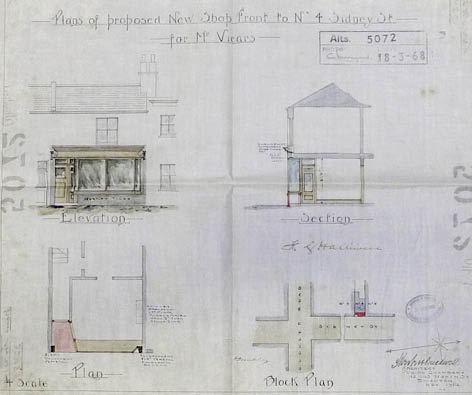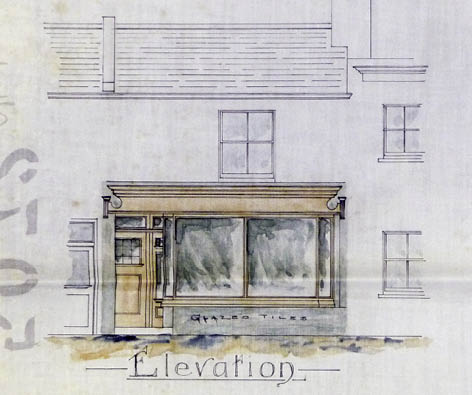Street history - Sydney Street
Lead researcher Shirley Allen
Download the Sydney Street history as a .pdf (1.8Mb)
Introduction
This study of Sydney Street looks at its origins, its development, and its relationship, over the years, to Brighton itself. Today, Sydney Street is popularly recognised as being part of Brighton’s bohemian quarter, with its atmosphere of cool cafes and food venues, its boutique-style shops selling jewellery, second-hand books and vintage clothes, and its unique, independent, specialist providers. The street’s recent history (post-1975) is beyond the scope of this work. It is hoped, nevertheless, that those living and trading in the street today will find some interesting connections with the people and events belonging to the history of this fascinating thoroughfare.
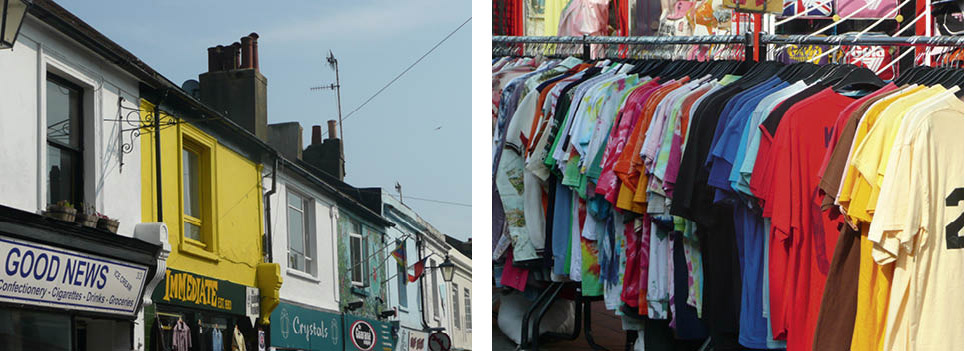
1) Vibrant Sydney Street today, a centre of activity and trade. Image courtesy of S. M. Allen
Development
Sydney Street stands in what was once commonly called the third furlong of the North Laine and runs between the two larger streets (originally called ‘leakways’) of Gloucester Road to the south and Trafalgar Street to the north. It has Tidy Street to the west and Pelham Square to the east. It is part of the North Laine, one of the five ‘laines’ or large fields originally surrounding the emerging town of Brighton in the late 18th century. The North Laine was used as a market garden area for the town’s nearby population. Examination of The Brighton Terrier map of 1792 suggests it may have been the long-established and local Scutt family who initiated the development of Sydney Street.
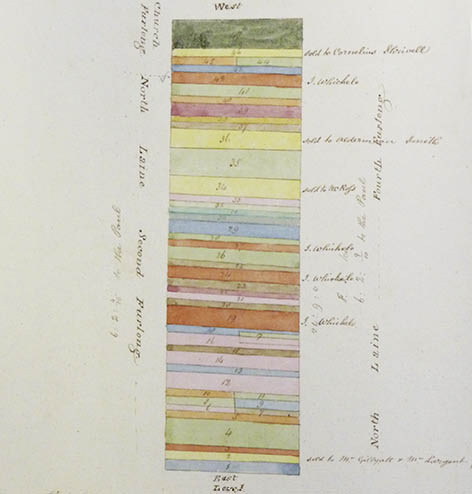
2) Detail from the 1792 Terrier’s apportionment list showing
landholding interests in Sydney Street. Image courtesy of
East Sussex Record Office
3) Terrier map of Brighton, 1792 (Third Furlong here shown framed). Image courtesy of East Sussex Record Office. Enlarge
The origin of the street’s name is also not entirely certain, though Tim Carder in ‘The Encyclopaedia of Brighton’ suggests it may follow the pattern of a few other Brighton streets in being named after a notable viscount.1 Early maps of the area, and early Census Reports, give two different spellings for the street: ‘Sidney’ and ‘Sydney’.2
Sydney Street developed over time, with individual speculators creating single properties or short rows. By the time works were complete, the street boasted over forty-five properties.
Architecture and materials
At first glance, Sydney Street seems noticeably different from many nearby streets, its commercial face, today, being its defining characteristic. However, when first built, Sydney Street was much more similar in finish to a large number of the nearby residential streets than is immediately apparent.
Looking upwards, at the higher parts of the buildings, the shared early design with neighbouring streets is revealed. At ground level, the shops, today, have a fairly uniform finish and it might be thought the properties do not have lower ground floors. However, close inspection reveals that this is often untrue; set into the pavements are cast iron grids with inset glass cubes. These are ‘lights’ introduced to illuminate basement areas.
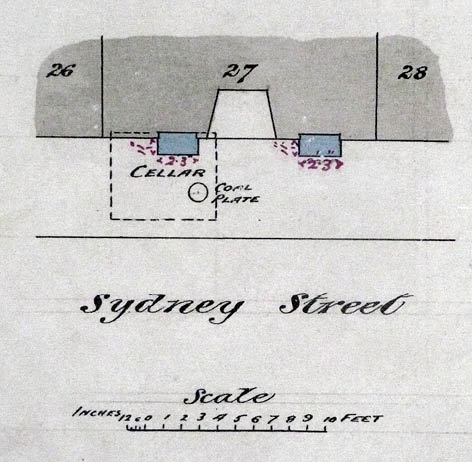
4) Early-20th century plan for pavement lights at No. 27
Sydney Street. Image courtesy of East Sussex Record Office
The presence of these lights leads to an interesting question. Were the original properties of Sydney Street provided with front areas and cast iron railings, and were these sacrificed to provide wider pavements for shoppers as the street became more commercial, so that the front areas were covered over with the cast iron lights? Hopefully, in the future, it will be possible to gain access to a number of the lower ground floors in the street and deduce whether front areas were a part of the street’s original character. Certainly, in nearby streets there are properties that retain narrow front areas and cast iron railings to the front elevations, which suggest this may have been the case.
Like so much of our local 19th century architecture, the properties of Sydney Street are constructed principally of Bungaroosh (the Sussex name for flint and lime wall), local brick, Roman cement, lime-plaster and timber. Modern materials, like Portland cement, gypsum plasters, plastic and aluminium are making an ever more regular appearance, as maintenance and repair impact on the properties, but the simple, clean 19th century architectural lines remain visible and contribute greatly to the street’s ongoing appeal.
Amenities and alterations
Our research has not yet established when utilities such as gas and electricity were first installed in the street and this is something that requires investigation. There are, though, easy-to-access and extensive records of properties being modified at the start of the 20th century. The works recorded relate mostly to two types of alteration; commercial facades being changed to keep up with style and changes in technology, and the fronts of residential properties being changed to provide for commercial activity.
The former of these developments can clearly be seen in the drawings reproduced below. In the image of The Green Dragon public house, at 9 Sydney Street, the proposal is to replace the Georgian glazed windows of the upper floor and south ground floor with large glass panes inserted into three-sided bays. The north ground floor window is also to be updated, with four glass panes replaced by two.
Additional alterations are planned for the upper floor; the central flat rendered panel is to be enlarged, the two classical pilasters at either side of the upper elevation is to be removed and additional flat rendered panels added here, presumably to allow for extra painted signage.
5) Alterations to The Green Dragon, 1890. Image courtesy of East Sussex Record Office. Enlarge
At Number 25 an example can be seen of where a residential property is altered for commercial use. Here, an attractive, simple, classical façade is lost to the introduction of a very large shop front, which originates on the adjoining property. The quality of the new commercial front is considerably reduced in comparison with the one that is lost (where panel detail is evident in the lower section of the façade). The new construction is simply raised up from a dwarf wall.
The increasing popularity of large areas of glazed frontage is seen also in the plan for Number 4, at the opposite end of the street. Although a narrower shop front than that used at Number 25, the drawing clearly shows the desirability of large panes.
6) New Shop Front at No. 25, 1907. Image courtesy of East Sussex Record Office. Enlarge
7) Plan for 4 Sydney Street, 1902. Image courtesy of East
Sussex Record Office. Enlarge
8) Detail showing large Window Panes installed at No. 4,
1902. Image courtesy of East Sussex Record Office. Enlarge
Notable buildings
North Hall: Maps from the early nineteenth century, which pre-date the building of Sydney Street, show a cluster of buildings to the east of Tidy Street marked as ‘North Hall’. In the 1822 Baxter’s New Brighton Directory there is a listing for North Hall as ‘W. Largent’s Academy’. W. Largent is then listed as a cork cutter.3 The 1828 Pigot’s Directory, under Cork Cutters, lists Wm. Largent, North Hall. The next reference we have found to North Hall is in the 1841 Census (Sub District: St. Peter), where the following entries exist:
Gloster Cottages
Orphan Asylum
North Hall Cottage
Cheltenham Place
North Hall Cottage is also listed in the 1851 Census but it’s the Orphan Asylum that is perhaps of interest in relation to North Hall itself. This is noted as having twenty-six residents (including two adult women). Did W. Largent’s Academy become the orphan asylum? An entry in the MyBrightonandHove website suggests this may be true. It states, ‘The Female Orphan Asylum was founded in Western Road in 1822 by Francois de Rosaz, and later moved to the top of Gloucester Street where it now meets Sydney Street’.4
More about exactly what happened to the Academy/Orphan Asylum, as Sydney Street developed, will become a matter for future research.
Ownership
Most properties during the nineteenth century would be let to tenants, who might rent anything from a single room to a whole house.
Sets of deeds and related papers are a useful way of tracking those involved with a property, from developers, through to owners and tenants. Such documents relating to Number 27 illustrate this point. The first record dates from 1854, when Abraham Taylor died. His two sons acquired the property in 1855. Thereafter, there are documents down the years, listing the ownership and tenancy arrangements for the house, ending with Messrs. H. J. and E. E. Dorking leasing and holding the freehold of the property from 1958 until 1968.5
Census Records and, to an extent, Directories, provide us with good data about the families living in the street during this period. It is clear that quite often houses contained two, sometimes three separate families (e.g. Numbers 4, 6, 27, 42 in 1851), which could each include extended family members, as well as boarders, lodgers and occasionally servants, who were usually young teenage girls.
Some sizeable households can be found at the following properties: the Bennetts (Number 16, 1871), the Blockleys (Number 38, 1851), the Brunns (Number 15, 1871, 1881), and the Carters (Number 47, 1881) all had six family members. The Conways (Number 7, 1881), the Cramps (Number 2, 1861) and the Rolfs (Number 38, 1911) all had households of seven. By 1891 there were eight in the Carter household. The Crown family also had eight at this time, and in 1891 the Crowcher family (Number 31) could boast a family of ten. Sometimes families extended their premises or moved to other houses (e.g. the Conway family, consisting of nine members in 1871, are recorded at Number 36 in that year and at Number 7 in 1881.)
Several families, of course, would remain in the street for many years. Some examples are: the Barber family at Number 30, who lived in Sydney Street for at least twenty years (1881-1901), the Bell family at Number 8, and the Boys family at Numbers 22 and 23, who stayed for at least thirty years at their respective properties (between 1881-1911), the Dumbrell family at Number 39, the Long family at Numbers 13 & 14, and the Pilfold family at Number 35 who all lived in the street for at least forty years (between 1871-1911). Census records, from which the above has been taken, are produced only every ten years. By referencing Directories, it may be possible to extend these occupancy records even further.
During its early years, the street was populated overwhelmingly by people from the Sussex area and this remained so for some years. However, as mobility increased with the development of the railway network and the introduction of low cost fares, new residents to Sydney Street arrived from further afield, in particular from Kent, Surrey, Hampshire, London, Essex and Middlesex. There were also residents from Suffolk, Norfolk, Cambridgeshire, Oxford, Dorset, Devon, Cornwall, Derbyshire, Yorkshire, Lancashire, as well as more far-off places such as Limerick and The Channel Islands. Perhaps though, the most unusual mention for its time (1891) is the resident of Number 45, Mr Spyridion Marketis, a jewellery worker from the Ionian Islands (another man with a large family, recorded as having eight children).
Many of the women, during the latter stages of the nineteenth century, are listed as dressmakers and milliners. There were also a number of schoolmistresses. The 1870 Education Act decreed that five to thirteen year-olds were to be educated, and from 1871 a plethora of ‘scholars’, some as young as two years old, are recorded as living in the street. (It was typical of the time to find parents denominating children as ‘scholars’ in the Census). Most children in the street who were of school age would have gone to the educational establishments then in York Place and Pelham Street.
Residents
Sydney Street is, and has always been, a lively area and some Brighton residents can still remember the days, when over half a dozen butchers, in white aprons and straw hats, auctioned their meat off for the weekend with the call of “Cheap chops, bargain brisket, and a pound of sausages thrown in – you can’t say fairer than that now, can you!”
One of the many intriguing personalities from the street’s history, is a man called Walter Blink Gardner (1850-1923). Born in Chichester, he arrived in Brighton with one of his brothers in 1870, when he was just twenty years of age. He married Caroline Augusta Boulter and had a daughter, Maud Eveline. By 1881 he is recorded as living in Sydney Street and described as a ‘photographer’, with a studio in Lewes Road. By 1884 he was in Somerset.
Walter Blink Gardner worked as an itinerant photographer and travelled around the country with his camera, touring Sussex, Somerset and Kent. During the 1890s he travelled around with touring fairs.6 It seems it was his own choice to insert the name ‘Blink’ in front of his surname.
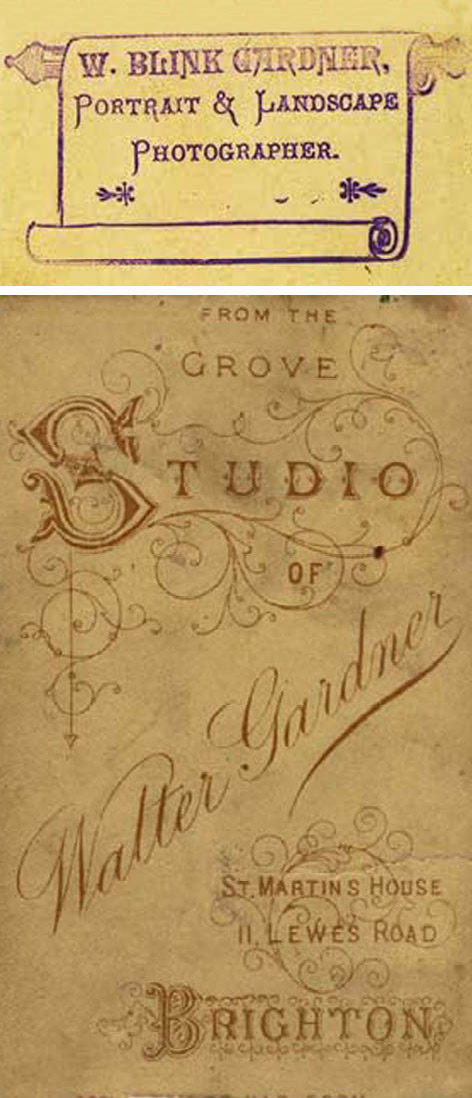
9) Walter Blink Gardner’s Business Cards c. 1888 & 1890. Images courtesy of David Simkin of Sussex PhotoHistory
Trade
Sydney Street, today, is all about shopping, and shops have been important to the street for many, many years. This can be seen in surviving street directories. Kelly’s directory of 1845 records eight businesses. By 1854, Taylor’s directory records twelve. In Folthrop’s 1859 edition there are fourteen. In Page’s 1878 publication there are sixteen. In 1921, Pike’s records thirty-two. From this point onwards, commercial activity in the street continues to develop, until eventually, there are few houses left which are solely residential.
It is interesting to note how the names and even the nature of the occupations have changed in the street over the years. For instance, a ‘straw bonnet maker’, a ‘coal merchant’ and a ‘beer dealer’ are listed in the 1845 Kelly’s Directory. At Number 2, from 1845 to 1862, there worked a ‘piano carrier’. A ‘basket-maker’ is recorded at Number 42, between 1861 and 1871. A ‘coach builder’ lived at Number 33 in 1875, and at Number 35 in 1889. There was even a ‘cattle dealer’ in the street, at Number 33 in 1885.
The terminology used for trade over time is also worthy of note. For example, does the ‘fruiterer’ become a ‘greengrocer’? Does the ’beer retailer’ subsequently get listed as maintaining a ‘public house’? Perhaps the best example of changing meaning is the wardrobe dealer. He did not, in fact, sell furniture, but second-hand clothing. Might this last group be the precursors of the street’s now famous ‘vintage clothing’ shops?

10) Advert for Rush Wardrobe Dealers Left-off Clothing.
Source, Kelly’s Directory 1921-22. Image courtesy of the
Royal Pavilion, Libraries and Museums, Brighton and Hove
In broad terms, it could be said that, over the years, the street’s businesses appear to fit into three main groups. One is concerned with the occasional needs of households (porters, builders, carpenters, sign-writers, painters and decorators, ironmongers and furniture dealers), all consistent with the increasing urbanisation of the area. Another group appears to cater for the slightly more regular needs of the local population (including drapers, tailors, watchmakers, jewellers, boot repairers, leather sellers, toy dealers, physicians and hairdressers). The third (very large group) is concerned with people’s everyday needs, particularly foodstuffs (confectioners, fruiterers, grocers, greengrocers, bakers, fishmongers and butchers). The street has also had its fair share of drinking establishments. In 1910 there are eighty-one pubs listed in the North Laine area,7 three of which are in Sydney Street; The Abingdon Arms (at Number 21, 1866-1921), St. George & The Dragon (at Number 32, 1856-1914) and the street’s longest established licensed premises, The Green Dragon (now The Office, at Numbers 8 & 9, from 1848.)
In any location, some businesses endure longer than others. Whether due to configuration costs, goodwill or other factors, examples of this phenomenon are evident in Sydney Street. For example, Number 40, was first recorded as a bakery in 1848. Despite various changes of ownership (under the Leneys, Hunts and Charmans, and finally Perry Brothers), the premises remained a bakery for many years. Similarly, at Number 42, the Doran family, who worked as dyers and are recorded first in 1873, pass on their premises to the Co-op Dyeing Works, who continue the trade until 1916. Another example is the Gunn family. When they are recorded as fishmongers at Number 6 in 1918, the address had been established as such since at least 1908.
Of course, sometimes it is the family name which endures over long periods, with multiple generations continuing a trade. Examples of this are apparent in relation to Dumbrells, the furniture dealers, at Number 39 (1864-1947), the gasfitters Long & Sons, at Numbers 13-14 (1864-1957), and Boys the leather sellers, at Numbers 22-23 (1879-1965).
To form a picture of the street’s commercial development over time, it is useful to study records spaced several years or even decades apart. The 1923 Kelly’s Directory shows Sydney Street having wardrobe dealers, general dealers, boot repairers, clothiers and tailors, and numerous food-based shops. Among these are a confectioner, two fishmongers, several fruiterers, a baker at Number 40, and two butchers. The butchers are: Felix Bonger at Number 12 (a ‘ham and beef dealer’) and Lane/Brown at Number 37. Dr. Lumsden, a medical practitioner, was located at Number 46. In the 1938 directory there are five butchers listed.
After the Second World War there is still a significant number of food shops, and still plenty of butchers – although these are now joined by cycle dealers, wool stores, and cafes at Numbers 28 and 42.
By 1968, seven butchers are mentioned in the Kelly’s Directory and the Saturday afternoon meat auctions had become a feature of the street. At this time there was also a second-hand record shop at Number 46. During the 1960s and 1970s, with the growth of the supermarket and out of town shopping, the food shops began to decline and the street began to take on more of its present-day bohemian character.
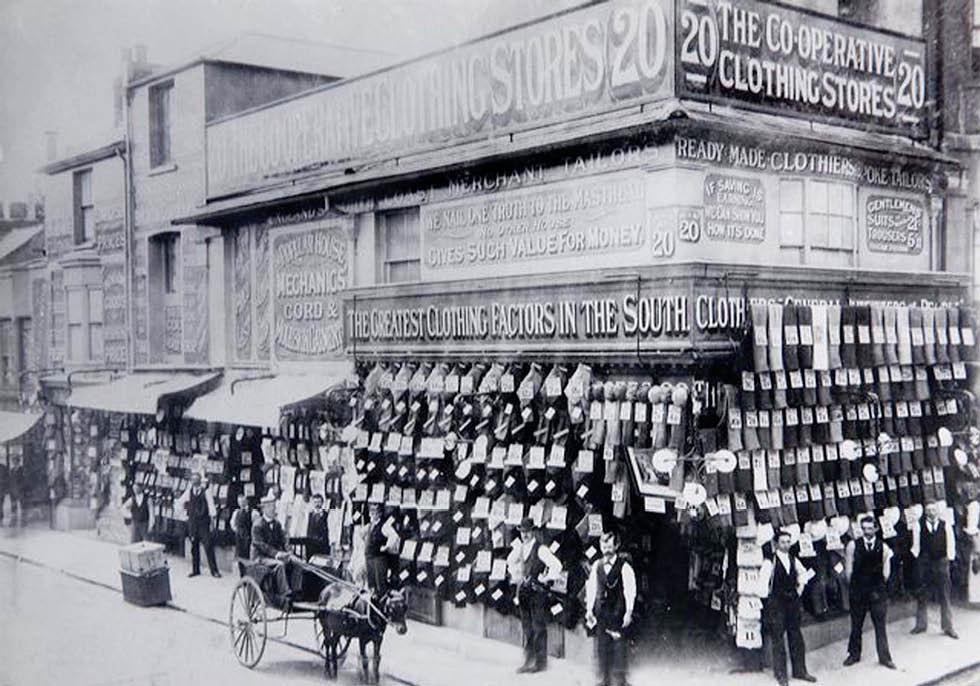
11) The Co-op Clothing Store at the corner of Sydney Street & Trafalgar Street, c. 1900. Image courtesy of The Regency Society. For further details about this photograph, see: http://www.regencysociety-jamesgray.com
Social life
Sydney Street has always had a strong commercial thread, but this has not negated entertainment and social life in the street. With three pubs, the thirsty workers and residents had plenty of opportunity to take a well-earned break. Today Sydney Street is home to the popular pub, The Office, where Brighton’s present day residents can relax after a hard day’s work.
Health
In the early 1900s there were certain features common to the North Laine area with regard to general health issues. These involved poor sanitation, the grime of nearby industry (e.g. from Foundry Street), poor heating and lighting and the problems of overcrowding. However, Sydney Street had a number of distressing tales of its own and aspects of these, whilst involving particular individuals, may also fit into a bigger picture of the times.
The Coroners’ Reports for 1904 contain interesting records for several households in the street, particularly Numbers 43, 5 and 27.
At Number 43, on the 3rd of July, Daisy Theakla Elizabeth Buckman died from natural causes, namely, broncho-pneumonia, following measles. She was aged 18 months and passed away in the presence of her mother, Sophia Buckman. The police report stated that “the deceased had suffered for some time, was under the care of its father when it appeared to have a fit and the doctor was called.” (The inquest took place at The Canteen, 20 Gloucester Road, which was a public house. At this time, public houses were quite often the accepted venues for inquests.) It appears the child had had bronchitis the previous September and had an attack of chicken pox shortly after Christmas and, more recently, had shown signs of measles. Dr. James Booth, performing the post-mortem on the 4th of July declared, “the body was wasted and there was no fat anywhere.” The mother stated that after Christmas “it had chicken pox and pneumonia” and that later she “improved but was always weary…On Sunday it had another fit.” Dr. Tocker declared, “I had previously attended the deceased for lung trouble. It was a weakly-nourished child.” From a modern perspective, it is striking that the young girl is so frequently referred to as ‘it’, even by her own mother.8
On the 19th of July, in another Coroner’s Report, the death is recorded, on the previous day, of Elizabeth Emily Smith, of Number 5 Sydney Street. The Coroner declared that she “did kill herself by swallowing a certain poison, to wit, oxalic acid, whilst temporarily of unsound mind.” This, of course, was at a time when such an act was still illegal. She was forty-one years old. Her husband, John Smith, stated that “she had been very strange for some time past. She had been subject to delusions, fancying she heard voices....but I had no reason to think that she would take her life”. Elizabeth Smith and her husband had lodged with a Mrs. Emma Bicknell, a widow, for two years at Number 5, and in the latter’s statement she said, “I have noticed the deceased to be strange in her manner for some time and she has been subject to the delusions mentioned by her husband.” How much support poor Elizabeth had received for the “mental troubles” her husband refers to is open to question.9
The final health report for 1904 is for one Henry Knott of Number 27 Sydney Street, who died “suddenly from natural causes...due to fatty degeneration of the heart and Bright’s disease.” He died in the presence of his wife, who stated that her husband “had been under an operation at Sussex County Hospital for a very bad stricture about twelve months ago and had been under medical treatment on and off since”. He was obviously a very poorly man and, although the case might not appear as immediately poignant as the previous two, it is worth noting his death at the relatively young age of fifty-two.10
Moving forward some thirty years, a report of 1934 states that, on the 25th of January, Sheila Phyllis May Smith, of Number 45 Sydney Street, died at The Royal Sussex County Hospital. The cause of death was stated as “shock following extensive burns due to her clothes catching fire.” Sheila was three years old, “a healthy child” who had “never needed any medical attention.” At the time of the incident she was being looked after by her aunt, Beatrice Hilda Smith, who was only fourteen and who states that they were alone in the basement, in the living room, where there was a low fire. “We sat in chairs, by the side of each other, writing for some 10 minutes.” Beatrice left the room for only a few minutes to fetch a flannel and when she returned found that the child “had got down from the chair and I saw her near the door with her clothing on fire.” She ran to Gloster Terrace [sic] to fetch her mother (the child’s grandmother), who applied olive oil obtained from Mr. Bridger the grocer, wrapped her in a blanket and waited in Dr. Lumsden’s surgery for the ambulance. She accompanied her to hospital and remained with her until she died the next day.
There are witness statements from two passers-by, and a horrific report from the House Surgeon at the hospital, which details the child’s injuries. A statement from the Police Sergeant gives some rather damming evidence that, at the home, there was “no iron guard or any means of safety except brass arts of low design.” This, together with the reminder that the child had been left in the care of a fourteen year old, may have had some bearing on the correspondence between the Coroner and the N.S.P.C.C., who were considering prosecution. They decided not to proceed, considering that “lessons had been learned by the parents.” Hopefully, this may have been of some comfort to them, as what adds an almost unbearable dimension to this tragedy is that the arrangement of Sheila being looked after by her aunt was because her father was visiting his wife in the Maternity Unit. In times of perhaps less welfare support, the family was obviously doing what was customary in trying to care for each other – and even today it is a story which resonates. We have not yet looked into Sheila’s mother’s subsequent history or that of poor Beatrice, following her few moments’ lack of supervision.11
Events
Besides the type of incidents reported above, Sydney Street seems to have been relatively free of troublesome events. There are records of crimes and disturbances as would be expected in any busy street. However, extensive research over several months has not turned up any major negative activities of note. On the other hand, there are a couple of lighter moments, which amuse rather than disturb. Both were in the year of 1881.
The first, reported in the ‘Brighton Herald’, in April, saw the landlord of The Green Dragon and three of his customers summoned to Brighton police court for drinking out of hours (between twelve and one ‘o’clock on a Saturday night). The article reads, ‘They stated, amidst the merriment of the court, that they had been conversing seriously on the qualities of the late Benjamin Disraeli, Lord Beaconsfield, whose death had just been announced. The time had flown so rapidly, they claimed, that they were not aware it was so late.’ The Magistrate reckoned this was “a likely story” and fined the landlord 10s and costs, and the others 2s 6d’.12
The second story is a ‘traffic incident’, reported 13th May in the Argus, under the heading ‘Spilt Milk’ and involves a plaintiff seeking ‘to recover 12s.6d. for damage done to a milk perambulator and the value of eight gallons of milk.’ It seems that while the plaintiff, a Mr. Ashdown, was delivering milk in Sydney Street, he left the said perambulator in the gutter and a Mr. Young, driving a four-wheeled van, ‘entered the street and on nearing the perambulator threw the reins upon the horse’s back and called to the animal to stop. Before the animal could obey, however, it struck the milk-can with its feet, damaged it to the extent of 1s. 6d., and upset about eight gallons of milk, worth 1s. 4d. a gallon.’ The plaintiff won his case, with costs.13
More recent events
In the 1950s, 60s and 70s homeowners is Sydney Street who wanted to sell their properties, at a price they considered reasonable, found it extremely hard to do so due to the Corporation’s plans for road improvement. The most notable of these was the Gloucester Road Widening Scheme, which would have cut through and devastated the North Laine. Potential vendors often found themselves in protracted correspondence with the Borough’s officers, and facing great difficulty in attracting potential buyers to a property with an unsure future. Examples of the difficulties faced are apparent in surviving documentation.
At Numbers 108-109 Gloucester Road/1a Sydney Street, for example, the surveyor acting for a Mr. Swayne asked, in 1959,
“…as the property is situated in an area scheduled for future road widening, my client is having difficulty affecting a sale. Therefore, would the Corporation be interested in acquiring the property?”
When the Corporation declines this offer, Mr. Swayne’s surveyor asked,
“…our client must now try to affect a sale elsewhere and prospective purchasers will want to know the Corporation’s future intentions re. this area. We assume that, as the Council have decided not to purchase, these properties will not be affected by any scheme.”
But plans were, indeed, being anticipated for the area and other residents were caught in the Borough’s development trap.14
At Number 43 Sydney Street, in 1964, Mr Roberts was having similar difficulties to those of Mr. Swayne. He had planned to migrate to Australia with his wife and daughter but was also not able to find a buyer for his home and he appealed to the Borough Surveyor, writing,
“I consider it grossly unfair that a taxpayer should have no justice in being able to dispose of his assets, thereby being able to safeguard his future elsewhere. It is the last remaining house in Sydney Street easily converted into a shop, as you have done with the others in this street. Please expedite this matter one way or another, as soon as possible, as this time I am definitely fulfilling my plans, and have passages to book’.
Mr Roberts also contacted the Borough Valuation and Estates Department. He wrote,
“I appeal to you to consider the hardships to me and my family if a sale doesn’t go through. Everything is arranged to go to Australia, as it was 2 years ago when your department vetoed the private sale and the Corporation rejected it... surely one has the right to sell his own property.”
Subsequently, due to more unsuccessful attempts to sell and the complaints that ensued, the Corporation was obliged to buy the property for £3,000, and went on to invite applications for a suitable tenant. When the said tenant eventually left, the Corporation sold the property in 1977 for £7,750.15
It was a similar story in 1972, for the owner of Number 44. Her agents, writing on her behalf, set out the situation for the Corporation, stating,
“…she will be 75 April next and anxious to sell to supplement her pension. The proposals are causing hardship, preventing either selling or letting on satisfactory terms... Therefore it is important to sell the freehold interest and I ask the Estates Committee to reconsider their decision due to our Client’s circumstances.”
However, the decision was made not to purchase the property.16
This parlous situation affecting North Laine properties was ultimately turned into a triumph and one of Brighton’s great conservation success stories. This was very much due to the energies and efforts of a forward-thinking Brighton Borough Planning Officer, Ken Fines, who,
“... successfully proposed that the long-threatened district, then known vaguely as the ‘North Road area’, be designated a conservation area, and named North Laine after the old open field system. Before long it was declared outstanding by the Government for grant purposes.”17
Ken Fines died in 2008. There is a tree in Sydney Street planted in his honour and a local bus is named after him.
Conclusion
This document is a celebration of Sydney Street. It is an invitation to take pleasure in a thriving street which has not merely survived, but re-invented itself. All sorts of interesting connections are to be found linking past and present. For example, today’s Si Signore restaurant was previously home to a ham and beef dealer; Gunn’s Florist was formerly the workplace of an ‘artist in paper flowers’; Yum Yum’s once functioned as a fruiterer and greengrocer; ‘Dirty Harry’s’ jeans shop and several other vintage clothes shops once accommodated drapers and dressmakers; Vivid (Design & Print Co.) formerly boasted a signwriter; The Dumb Waiter was once the ‘Cosy Cafe’; and Penetration tattooists used to function as an artist and oil & colour dealer.
A conversation last year with the present resident at Number 45, the owner of Bonsai Ko, revealed his love of Greece - he might already have noticed that it was Mr. Marketis, the jeweller from the Ionian Islands, who once lived at his address. A previous resident of Clippers Men’s Hairdressers was also, like the present occupiers, concerned with image – and that was the enigmatic travelling portrait photographer, Walter Blink Gardner.
In closing, we would like to offer this document, for those interested in Sydney Street, as an invitation to find out more about its fascinating properties and the people who have lived and worked there in the past. It is also a suggestion, when wandering along the street, to look up at its first floors and down at its pavement, where the history of Sydney Street is still visible. And long may this be so.

12) Two of Sydney Street’s historic features still on view. Image courtesy of S. M. Allen
References
- Carder, T., (1990), The Encyclopaedia of Brighton, section 151e
- 1852 Rapkin Map of Brighton, John Tallis & Company, London & New York, published by Whitehall Press Ltd., London & Maidstone, England
- Baxter., (1822), New Brighton Directory, page 16
- Carder, T., (1990), Eastern Road from The Encyclopaedia of Brighton on http://www.mybrightonandhove.org.uk/page_id__8091.aspx (accessed 04/09/2011)
- Taylor-Avery-Creswell-Dorking-Conway, ACC5310/133, ESRO
- http://www.photohistory-sussex.co.uk/BTNGardner.htm ‘Walter Gardner - Brighton Photographer’ (accessed 07/07/2011)
- North Laine Runner, 1996, ‘Times past in the Runner’, Brighton History Centre
- Buckman , COR/3/2/1904/10, ESRO
- Smith, COR/3/2/1904/107, ESRO
- Knott, COR/3/2/1904/190, ESRO
- Smith, COR/3/2/1934/10, ESRO
- http://www.nlcaonline.org.uk/page_id_688_path_0p5p40p.aspx ‘The magistrate said “A likely story!” from the Brighton Herald, April 1881. Previously published in the North Laine Runner, No.201, Nov./Dec 2009 (accessed 18/08/2010)
- The Argus, May 13, 1881, page 3, ‘Spilt Milk’, Brighton History Centre
- 108-109 Gloucester Road and 1A Sydney Street , DB/A1/527, ESRO
- 43 Sydney Street, DB/A1/547, ESRO
- 44 Sydney Street, DB/A/1/558, ESRO
- http://www.nlcaonline.org.uk/page_id_383_path_0p18p95p.aspx ‘Ken Fines, ‘North Laine: story of an outstanding conservation area’ (accessed 18/08/2010)
Additional Bibliographic & Website References
- Carder, T., (1990), The Encyclopaedia of Brighton
- Collis, R., (2010), The New Encyclopaedia of Brighton
- Street Directories: including Baxter, Folthorp, Taylor, Towner-Curtis, Towner, Robinson, Walser and predominantly Page, Pike, Kelly
- Maps of Brighton (1792, 1826, 1847, 1852, 1873, 1876), Brighton History Centre
- Brighton Terrier (1972, 1973), ibid.
- Newspaper articles: The Argus, 1881, Cuttings Folder, ibid.
- Documents from East Sussex Records Office (ESRO), including Alteration Drawings, Conveyancing Documents and Coronors’ Reports
- www.nationalarchives.gov.uk/a2a/ (accessed 16/04/2011)
- www.ancestry.co.uk/ancestry(accessed 28/08/2011) Census Records
- www.findmypast.co.uk (accessed 5/08/2011) ibid.
- www.nlcaonline.org.uk NCLA Online /History/ Development of the North Laine to 1900, North Laine in the 20th century and My Street/Sydney Street (accessed 18/08/2010)
- www.mybrightonandhove.org.uk (accessed13/05/2010)
- www.geograph.org.uk/photo/2522389 (accessed 27/07/2011)
- www.regencysociety-jamesgray.com/volume25/source/jg_25_142.html (accessed 31/08/10)
- www.photohistory-sussex.co.uk (accessed 11/09/2010)

